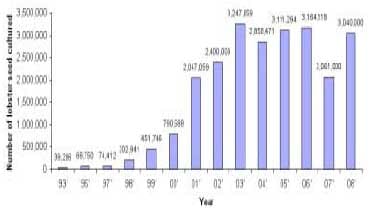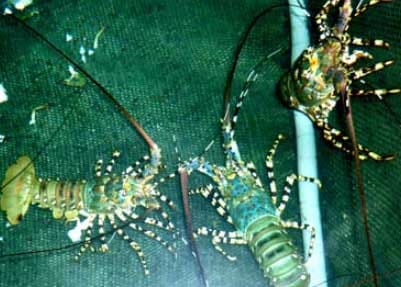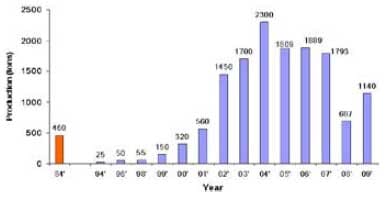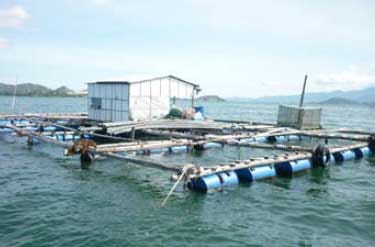Currently, lobster production has extended to five central provinces Binh Dinh, Phu Yen, Khanh Hoa, Ninh Thuan and Binh Thuan. The waters off these provinces are characterised by year round water currents of 2-4 cm/s, water depth of 9-20 m, salinity of 30-34‰, water temperatures of 22-32°C and protection from rough weather conditions.

Figure 1. Annual number of lobster seeds cultured in lobster farms in central coastal provinces.
The culture of lobster in the central provinces of Vietnam is valued annually at USD 100 million (MARD 2007). The breakdown of the cultured species varies with each coastal province (Table 1), but, generally P. ornatus is the most commonly cultured species, averaging at 74%, followed by P. homarus (20%) and P. polyphagus (6%). Vung Tau province, with its muddy seabed is more favourable to the species P. polyphagus which accounts for 80% of the lobster production in this area. The culture period varies with the cultured species. P. ornatus takes about 20-24 months to reach the commercial size of 800-1,000g/ piece, whereas the other species require 12-15 months to reach 200- 300g/piece.

Table 1. Percentage of lobster species cultured in the different provincial coastal zones.
Lobster farming today
The production relies on the collection of wild seeds, using seine-nets, traps and divers from as many as 30 sites from Thua Thien Hue in the north, to Vung Tau in the south. The seeds (post larvae) ranging from 7 to 15 mm carapace length, depending on the season and the equipment used, are sold to the lobster nursery and grow-out farms. The annual seed harvest for the three main species increased from over 39,000 in 1993 to over 3 million post larvae in 2006 with P. ornatus comprising 70% of the total.

The milky disease that appeared in late 2006 affected seed populations in 2007, which declined to around 2 million but then recovered to about 3 million in 2008 (Figure 1). We estimate that seed numbers in 2009 would be approximately the same as 2008.

Figure 2. Annual production of cultured lobsters in the central coastal provinces.
Annual lobster production reached around 2,000 tonnes in 2006- 2007, which is more than 4 times the peak yield in 1994. This was an 80 fold increase after 13 years. Only 25 tonnes were produced in 1994 when lobster culture started. In general, the milky disease brought production down to about 700 tonnes in 2008 and which gradually increased to over 1100 tonnes in 2009 (Figure 2).

Figure 3. Inhibition zone of each pathogenic bacteria by Inve probiotic Bacillus strains on PYE plates.
Culture systems
Culture systems in each coastal zone have been adapted to the specific topographical features of each area. Suspended cages have the cage framework made of iron with each of the 6 sides covered by a nylon net of 5-15mm. These are hung up into the chambers of a raft made by wooden stakes. The cage dimensions vary with lobster size and are either 0.8x0.8x1.0m, 1.5x1.5x1.5m, 2.2x2.2x1.5m or 2.7x2.7x1.7m. This rearing technique is selected for shallow areas with strong waves.
Floating cages consist of a wooden raft kept on the surface by a buoy frame and nylon net chambers. The bottom of the chambers is fixed by an iron frame. The chamber dimension is 3x3x6m or 4x4x7m or 4x4x8m. This model is selected for deeper areas with strong waves. Finally, suspended pens are used for shallow areas which are protected from wind and waves. The pen framework is made of salt-resistant wood with the 5 sides covered by nylon net. The dimensions are 5x5x6m or 6x6x6m or 5x6x6m. The bottom net is suspended 1 to 1.5m above the seabed.
Threats of diseases
Ten years after the first production of these lobsters in 1991, disease problems started to appear. The main diseases include red body, black gill, necrosis tail and white antennae or loose head. The fungus Fusarium solani was identified as the causative agent of black gill disease. At the end of 2006, a new disease, called 'milky haemolymph disease' appeared in numerous lobster production sites. In 2008, the disease led to a reduction in production to 700 tonnes produced and losses were estimated at USD 10 million. This was a disaster for lobster producers in these central provinces of Vietnam.
In mid 2007, The Ministry of Agriculture and Rural Development funded a project called 'the milky disease campaign' with the objective of treating this disease. Within a period of three months, local and foreign pathologists identified Rickettsia-like bacteria as the causal agent of the disease. Subsequently, a survey from some lobster farms in Phu Yen and Khanh Hoa provinces in 2008-2009 confirmed the prevalence of diseases such as milky haemolymph, red body and black gill.

Suspended 1.8x1.9x1.2m cages at Cam Ranh Bay for carrying out the experiment
The milky disease was reported from lobsters weighing 300-700g/ piece. Interactions between these diseases have not been detected. However, the infection rate varied, with the highest rates reported for the milky haemolymph and the lowest being reported for loose head (Table 2).

Table 2. Percentage of cage-cultured lobsters affected by the major diseases at Khanh Hoa and Phu Yen provincial coast in 2008.
To overcome disease problems, some farmers turned to antibiotics. They would mix trash fish with antibiotics such as streptomycin, tetramycin or doxycycline at 12g per kg of feed for up to 3-4 times per month according to the prevalence of diseases in the surrounding area. Alternatively, farmers inject oxytetracycline at 10 mg/kg lobster into the abdominal muscle or haemocoel at the first signs of milky disease. However, antibiotics are expensive and their effect has been variable and limited. Furthermore, there is the impact of antibiotics on the culture environment which is yet to be evaluated.
Pathogen free brood stock
To deal with this situation, the Vietnamese government has approved a national project for full-cycle P. ornatus lobster culture, with the objective of producing pathogen-free P. ornatus broodstock. This was supported by Ghent University and Inve Aquaculture. The research group also included Wageningen University, NCAFE (National Center for Agriculture and Fisheries extension) and RIA3 (Research Institute for Aquaculture No.3). The team carried out experiments on cage culture of brood stock culture P. ornatus lobsters at Cam Ranh Bay, Vietnam.
Based on the challenges facing the lobster industry and the limitations of antibiotic treatments, it was also decided to evaluate the effects of probiotics, breaded to trash fish, on the lobster P. ornatus. The parameters were growth, spawning activity and bacterial populations, determined from blood specimens.
Effect of probiotics
An experiment with three treatments in duplicate was carried out for five months in net-cages (1.8x1.9 x1.2 m) in Cam Ranh Bay. The selected P. ornatus lobsters, with carapace length of 98.1± 3.8 mm and weight of 866.7 ± 95.6 g, were fed daily with trash fish (small fish and crabs) that was mixed with Sanolife probiotics (Inve Aquaculture) at either 4 g/kg or 8 g/kg feed prior to feeding. The control treatment lobsters were fed trash fish without probiotics. Measurements of weight and size and blood analyses were carried out before the start of the experiment and on a monthly basis.

Table 3. Microbial variance in lobster blood during the experimental time from May to September 2009.
Blood samples were analysed for total bacteria, Vibrio, Taura and White spot syndrome virus (TSV and WSSV), and Rickettsia-like bacteria (RLB) at the Biotechnology Institute, Hanoi. The specific and numerous colonies from the agar plates of TSA, TSFG or MA were subcultured and then sent out to Inve Technologies for inhibition tests with the Sanolife Bacillus strains. The results of the trial are summarised below:
• Analyses of blood samples. There was no difference between control and treatment in the concentration of total bacteria. The analyses for Vibrio (TCBS plates), TSV and WSSV (PCR) and Rickettsia-like Bacteria were negative (Table 3).
• Inhibition test in the laboratory. Cross-streaking inhibition test using PYE (Peptone Yeast Extract agar) confirmed the ability of the Sanolife Bacillus strains to inhibit the bacteria strains that had been isolated from the blood samples (Figure 3).
• Performance of lobster. The delivery of Sanolife probiotic (8 g/kg food) led to significant difference in moulting cycle, carapace length and spawning rate. Compared to the negative control, the moulting cycle was 81 days (versus 120 days), the increase in carapace length was 3.6 cm (versus 2.3 cm) and the spawning rate was 25% (versus 0%). The survival rate of 25% in the treatment (4 g probiotic/kg food) is thought to be due to milky disease. However, the animals were negative for Rickettsia-like bacteria (Table 4).

Table 4. Growth (Carapace length, CL), survival and spawning rate of the experimental lobsters from May to September 2009.
However, the mode of delivery of the probiotics requires further discussion. For example, do probiotics remain in the trash fish until they are ingested by the lobsters? Laboratory experiments showed that the Bacillus concentration was highest when the coated trash fish was kept for one hour prior to immersion in water (Table 5). Provided the initial coating was good, there was no difference in the Bacillus concentration after suspension of the coated trash fish in water for 5 or 30 minutes. The Bacillus were not leaching out of the trash fish.
The next step
The lobsters that were fed on trash fish mixed with 8 g of Sanolife probiotics per kg within an hour before feeding showed shorter moulting cycles, higher growth rates and improved spawning rates. The ability of Sanolife Bacillus strains to inhibit bacteria isolate from lobster blood has been confirmed in the laboratory but not confirmed in the field. An ongoing project is now aimed at improving the culture of lobster by a combination of probiotics and immunostimulants.

Table 5: Count of Bacillus when coated on trash fish.
January 2014




